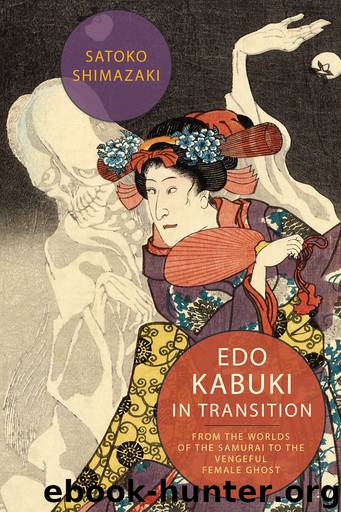Edo Kabuki in Transition by Shimazaki Satoko;

Author:Shimazaki, Satoko; [Shimazaki, Satoko]
Language: eng
Format: epub
Tags: shim17226, LIT008030, LITERARY CRITICISM / Asian / Japanese, LIT013000, LITERARY CRITICISM / Drama
Publisher: Columbia University Press
Published: 2016-03-02T16:00:00+00:00
[4]
The End of the World
Figures of the Ubume and the Breakdown of Theater Tradition
In the first production of Tsuruya Nanboku IV’s Yotsuya kaidan, the ghost of Oiwa, played by Onoe Kikugorō III, appeared in act 5 by emerging from a consecration cloth with an infant cradled in her arms. Oiwa was thus figured as an ubume (literally, “a woman giving birth”), a particular type of ghost associated with pregnancy and childbirth that would have had deep psychological resonances for the audience of Nanboku’s day. Nanboku had employed the ubume in a number of earlier productions, and it appears in almost all his major ghost plays. Ubume were ubiquitous in the theater and literature of this period, appearing again and again not only in Nanboku’s works but also in the fiction of major writers such as Shikitei Sanba, Santō Kyōden, and Kyokutei Bakin. Our interpretation of the meaning of this scene in Yotsuya kaidan must thus be tied to a larger understanding of Nanboku’s and the kabuki theater’s mobilization of the ubume as a dramatic trope and of the roles the ubume played in the broader context of nineteenth-century cultural production. In other words, we must complement my examination in chapter 3 of the long history of representations of female transformation, and of the layered meanings of the female ghost, by asking why ghosts in the theater and literature of the early nineteenth century were associated so pervasively with pregnancy and why the ubume became so popular as a motif, particularly in the first three decades of the century.
The Flowers of Kikugorō’s Farewell Performance: Ghost Stories at Yotsuya (Nagori no hana Yotsuya kaidan, 1826), an illustrated digest of the play published by Hanagasa Bunkyō I (1785–1860) and Keisai Eisen (1790–1848) immediately after the production, hints at how the scene in act 5 may have looked (figure 4.1). On the right, we see Ichikawa Danjūrō VII as Iemon, coming through a temple gate to pour water on a consecration cloth hung between four bamboo poles—an object known by the name of the ritual in which it is used: literally, “flowing consecration” (nagare kanjō). Iemon is offering a prayer for the repose of the spirits of Oiwa and their son even as he shudders with fear at the prospect of his dead wife’s revenge. The water in the ladle has turned into fire, a “soul flame,” a common visual representation of a spirit that either accompanies or stands in for the ghost itself. On the left-hand page, Oiwa’s ghost rises from the cloth, hugging the baby to her breast.
Download
This site does not store any files on its server. We only index and link to content provided by other sites. Please contact the content providers to delete copyright contents if any and email us, we'll remove relevant links or contents immediately.
Call Me by Your Name by André Aciman(19900)
Ready Player One by Cline Ernest(13978)
How to Be a Bawse: A Guide to Conquering Life by Lilly Singh(7154)
Wiseguy by Nicholas Pileggi(5315)
The Kite Runner by Khaled Hosseini(4951)
On Writing A Memoir of the Craft by Stephen King(4661)
Audition by Ryu Murakami(4612)
The Crown by Robert Lacey(4571)
Call me by your name by Andre Aciman(4463)
Gerald's Game by Stephen King(4373)
Harry Potter and the Cursed Child: The Journey by Harry Potter Theatrical Productions(4314)
Dialogue by Robert McKee(4160)
The Perils of Being Moderately Famous by Soha Ali Khan(4064)
Dynamic Alignment Through Imagery by Eric Franklin(3919)
Apollo 8 by Jeffrey Kluger(3512)
How to be Champion: My Autobiography by Sarah Millican(3493)
The Inner Game of Tennis by W. Timothy Gallwey(3472)
Seriously... I'm Kidding by Ellen DeGeneres(3412)
Darker by E L James(3405)
